Oxo(diphenyl)stannane
Modify Date: 2025-08-27 11:09:54
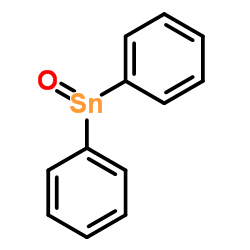
Oxo(diphenyl)stannane structure
|
Common Name | Oxo(diphenyl)stannane | ||
|---|---|---|---|---|
| CAS Number | 2273-51-0 | Molecular Weight | 288.917 | |
| Density | N/A | Boiling Point | N/A | |
| Molecular Formula | C12H10OSn | Melting Point | 320 °C (dec.)(lit.) | |
| MSDS | Chinese USA | Flash Point | N/A | |
| Symbol |

GHS07 |
Signal Word | Warning | |
| Name | diphenyltin oxide |
|---|---|
| Synonym | More Synonyms |
| Melting Point | 320 °C (dec.)(lit.) |
|---|---|
| Molecular Formula | C12H10OSn |
| Molecular Weight | 288.917 |
| Exact Mass | 289.975372 |
| PSA | 17.07000 |
| LogP | 1.22280 |
| InChIKey | VPPWQRIBARKZNY-UHFFFAOYSA-N |
| SMILES | O=[Sn](c1ccccc1)c1ccccc1 |
Synonym: Section 2 - COMPOSITION, INFORMATION ON INGREDIENTS
Risk Phrases: 20/21/22 36/37/38 Section 3 - HAZARDS IDENTIFICATION EMERGENCY OVERVIEW
Harmful by inhalation, in contact with skin and if swallowed. Irritating to eyes, respiratory system and skin. Potential Health Effects Eye: Causes eye irritation. Skin: Causes skin irritation. Harmful if absorbed through the skin. Ingestion: Harmful if swallowed. May cause irritation of the digestive tract. Inhalation: Harmful if inhaled. Causes respiratory tract irritation. Chronic: Not available. Section 4 - FIRST AID MEASURES Eyes: Flush eyes with plenty of water for at least 15 minutes, occasionally lifting the upper and lower eyelids. Get medical aid. Skin: Get medical aid. Flush skin with plenty of water for at least 15 minutes while removing contaminated clothing and shoes. Ingestion: Get medical aid. Wash mouth out with water. Inhalation: Remove from exposure and move to fresh air immediately. If not breathing, give artificial respiration. If breathing is difficult, give oxygen. Get medical aid. Notes to Physician: Section 5 - FIRE FIGHTING MEASURES General Information: As in any fire, wear a self-contained breathing apparatus in pressure-demand, MSHA/NIOSH (approved or equivalent), and full protective gear. Extinguishing Media: Use water spray, dry chemical, carbon dioxide, or chemical foam. Section 6 - ACCIDENTAL RELEASE MEASURES General Information: Use proper personal protective equipment as indicated in Section 8. Spills/Leaks: Vacuum or sweep up material and place into a suitable disposal container. Section 7 - HANDLING and STORAGE Handling: Avoid breathing dust, vapor, mist, or gas. Avoid contact with skin and eyes. Storage: Store in a cool, dry place. Store in a tightly closed container. Section 8 - EXPOSURE CONTROLS, PERSONAL PROTECTION Engineering Controls: Facilities storing or utilizing this material should be equipped with an eyewash facility and a safety shower. Use adequate ventilation to keep airborne concentrations low. Exposure Limits CAS# 2273-51-0: United Kingdom, WEL - TWA: (listed as tin organic compounds): 0.1 mg/m3 TWA (except cyhexatin, as Sn) United Kingdom, WEL - STEL: (listed as tin organic compounds): 0. mg/m3 STEL (except cyhexatin, as Sn) United States OSHA: 0.1 mg/m3 TWA (as Sn) (listed under Tin orga compounds). Belgium - TWA: (listed as tin organic compounds): 0.1 mg/m3 VLE ( Sn) Belgium - STEL: (listed as tin organic compounds): 0.2 mg/m3 VLE Sn) France - VME: (listed as tin organic compounds): 0.1 mg/m3 VME (a Sn) France - VLE: (listed as tin organic compounds): 0.2 mg/m3 VLE (a Sn) Germany: (listed as tin organic compounds): 0.1 mg/m3 VME (as Sn) Germany: (listed as tin organic compounds): Skin absorber Malaysia: (listed as tin organic compounds): 0.1 mg/m3 TWA (as Sn Netherlands: (listed as tin organic compounds): 0.2 mg/m3 STEL (a Sn) Netherlands: (listed as tin organic compounds): 0.1 mg/m3 MAC (as Spain: (listed as tin organic compounds): 0.1 mg/m3 VLA-ED (as Sn Spain: (listed as tin organic compounds): 0.2 mg/m3 VLA-EC (as Sn Personal Protective Equipment Eyes: Not available. Skin: Wear appropriate protective gloves to prevent skin exposure. Clothing: Wear appropriate protective clothing to prevent skin exposure. Respirators: Follow the OSHA respirator regulations found in 29 CFR 1910.134 or European Standard EN 149. Use a NIOSH/MSHA or European Standard EN 149 approved respirator if exposure limits are exceeded or if irritation or other symptoms are experienced. Section 9 - PHYSICAL AND CHEMICAL PROPERTIES Physical State: Powder Color: white Odor: Not available. pH: Not available. Vapor Pressure: Not available. Viscosity: Not available. Boiling Point: Not available. Freezing/Melting Point: 320 deg C (dec.) Autoignition Temperature: Not available. Flash Point: Not available. Explosion Limits, lower: Not available. Explosion Limits, upper: Not available. Decomposition Temperature: Solubility in water: Specific Gravity/Density: Molecular Formula: C12H10OSn Molecular Weight: 288.9 Section 10 - STABILITY AND REACTIVITY Chemical Stability: Stable. Conditions to Avoid: Incompatible materials. Incompatibilities with Other Materials: Strong oxidizing agents. Hazardous Decomposition Products: Carbon monoxide, carbon dioxide, tin/tin oxides. Hazardous Polymerization: Will not occur. Section 11 - TOXICOLOGICAL INFORMATION RTECS#: CAS# 2273-51-0 unlisted. LD50/LC50: Not available. Carcinogenicity: Diphenyltin oxide - Not listed by ACGIH, IARC, or NTP. Section 12 - ECOLOGICAL INFORMATION Section 13 - DISPOSAL CONSIDERATIONS Dispose of in a manner consistent with federal, state, and local regulations. Section 14 - TRANSPORT INFORMATION IATA Shipping Name: Organotin compound, solid, n.o.s.* Hazard Class: 6.1 UN Number: 3146 Packing Group: III IMO Shipping Name: Organotin compound, solid, n.o.s. Hazard Class: 6.1 UN Number: 3146 Packing Group: III RID/ADR No information available. Section 15 - REGULATORY INFORMATION European/International Regulations European Labeling in Accordance with EC Directives Hazard Symbols: XN Risk Phrases: R 20/21/22 Harmful by inhalation, in contact with skin and if swallowed. R 36/37/38 Irritating to eyes, respiratory system and skin. Safety Phrases: S 26 In case of contact with eyes, rinse immediately with plenty of water and seek medical advice. S 37/39 Wear suitable gloves and eye/face protection. WGK (Water Danger/Protection) CAS# 2273-51-0: No information available. Canada None of the chemicals in this product are listed on the DSL/NDSL list. CAS# 2273-51-0 is not listed on Canada's Ingredient Disclosure List. US FEDERAL TSCA CAS# 2273-51-0 is not listed on the TSCA inventory. It is for research and development use only. SECTION 16 - ADDITIONAL INFORMATION N/A |
| Symbol |

GHS07 |
|---|---|
| Signal Word | Warning |
| Hazard Statements | H302-H312-H315-H319-H332-H335 |
| Precautionary Statements | P261-P280-P305 + P351 + P338 |
| Personal Protective Equipment | dust mask type N95 (US);Eyeshields;Gloves |
| Hazard Codes | Xn:Harmful; |
| Risk Phrases | R20/21/22;R36/37/38 |
| Safety Phrases | S26-S36 |
| RIDADR | UN 3146 6.1/PG 3 |
| WGK Germany | 3 |
| Packaging Group | III |
| Hazard Class | 6.1 |
| HS Code | 2931900090 |
| Precursor 7 | |
|---|---|
| DownStream 6 | |
| HS Code | 2931900090 |
|---|---|
| Summary | 2931900090. other organo-inorganic compounds. VAT:17.0%. Tax rebate rate:13.0%. Supervision conditions:AB(certificate of inspection for goods inward,certificate of inspection for goods outward). MFN tariff:6.5%. General tariff:30.0% |
| oxodiphenylstannane |
| Stannane, oxodiphenyl- |
| oxodiphenyltin(iv) |
| Diphenyloxostannane |
| diphenyltin(IV) oxide |
| {(C6H5)2SnO}n |
| Dophenyltin oxide |
| (phenyl)2SnO |
| Diphenyltinoxide |
| Oxo(diphenyl)stannane |
| EINECS 218-883-8 |
| MFCD00058851 |
| DIPHENY TIN OXIDE |
| OXODIPHENYLTIN |
 CAS#:7732-18-5
CAS#:7732-18-5 CAS#:1135-99-5
CAS#:1135-99-5 CAS#:35569-19-8
CAS#:35569-19-8 CAS#:1062-67-5
CAS#:1062-67-5 CAS#:7647-01-0
CAS#:7647-01-0 CAS#:10074-32-5
CAS#:10074-32-5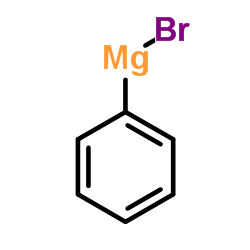 CAS#:100-58-3
CAS#:100-58-3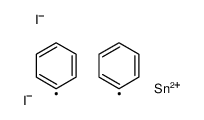 CAS#:14532-06-0
CAS#:14532-06-0 CAS#:595-90-4
CAS#:595-90-4![4,12-dimethyl-1,7,9,15-tetraoxa-4,12-diaza-8-stannaspiro[7.7]pentadecane structure](https://image.chemsrc.com/caspic/383/166277-59-4.png) CAS#:166277-59-4
CAS#:166277-59-4 CAS#:1064-10-4
CAS#:1064-10-4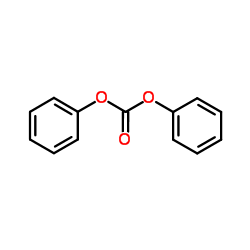 CAS#:102-09-0
CAS#:102-09-0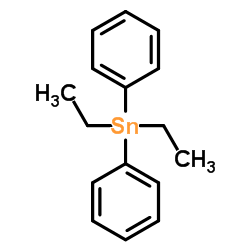 CAS#:10203-52-8
CAS#:10203-52-8